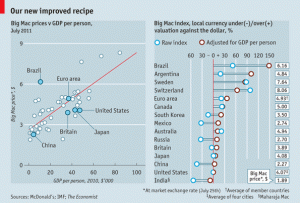Some Currency Data to Chew On!
Jul 29, 2011
The Economist updated the most recent “Big Mac Index” this week. The Big Mac Index is based on the theory of purchasing-power parity, the notion that in the long run exchange rates should move towards the rate that would equalise the prices of a basket of goods and services around the world. Based on this principle, the raw index shows how much a currency may be over or under valuated against the US dollar. However the per person GDP adjusted index offers a better guide to long run currency under- and over-valuation than the “raw” index since it . The first of two charts below demonstrates that a strong relationship exists between per person GDP and the price of a Big Mac. From the second chart we may conclude that currencies of Brazil, Argentina and Sweden are some of the most over-valued vis-a-vie the US dollar, and Canada stands at potentially 20% above its long term parity. We recognize however that exchange rates can remain out of line for some time as other factors such as sovereign debt levels, wage growth and productivity impact long term averages.

